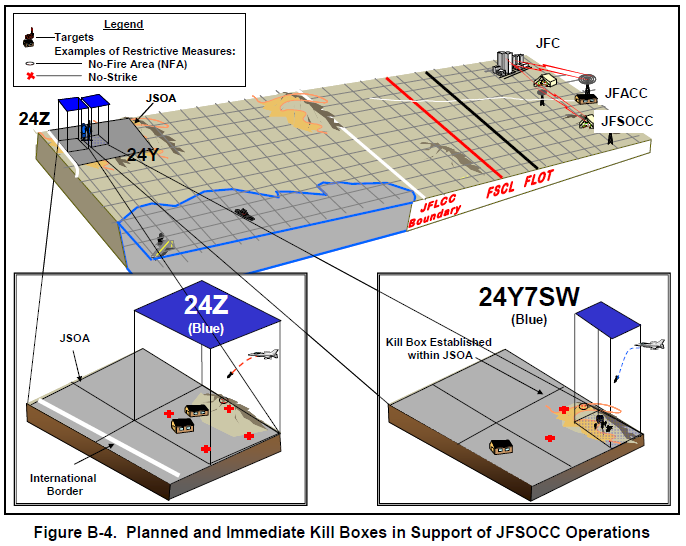 MULTI-SERVICE TACTICS, TECHNIQUES, AND PROCEDURES FOR KILL BOX EMPLOYMENT
MULTI-SERVICE TACTICS, TECHNIQUES, AND PROCEDURES FOR KILL BOX EMPLOYMENT
- 92 pages
- Distribution authorized to US government agencies and their contractors only to protect operational information from automatic dissemination under the International Exchange Program or by other means. This determination was made on 13 June 2005.
- June 2005
1. Purpose
This publication presents a doctrinal framework for kill box employment procedures across Service and/or functional components within a joint environment. A kill box is defined in Joint Publication (JP) 1-02, Department of Defense Dictionary of Military and Associated Terms, as: “A three-dimensional area reference that enables timely, effective coordination and control and facilitates rapid attacks.” Although a definition exists, there is no formal kill box doctrine or tactics, techniques, and procedures. Therefore, this publication updates the definition and establishes the kill box as a fire support coordinating measure (FSCM). The multi-Service tactics, techniques, and procedures described assist in developing, establishing, and executing kill box procedures to allow rapid target engagement.
2. Scope
This publication highlights kill box terminology and commonalities, presents known practices, and includes key lessons learned. It discusses multi-Service kill box planning, responsibilities, coordination, and support. Specifically, this publication provides an overview of kill box procedures, methods of employment, and coordination and synchronization.
This publication is not authoritative in nature, however, it is consistent with joint doctrine and provides principles that can help planners coordinate, deconflict, synchronize, and implement kill box procedures among the components assigned to a joint force. It covers planning and execution at the tactical and operational level. This publication will not be used by one or more Services, joint commands, other joint agencies, or other entities to obligate another Service in regards to doctrine, organization, training, materiel, leadership, personnel, and facilities.
3. Applicability
This publication provides the joint force commander (JFC) and Service components unclassified kill box multi-Service tactics, techniques, and procedures (MTTP) to implement within any area of operations (AO). The target audience includes commanders as well as the operations section (current operations, fires, and future plans) and intelligence section of Service components and their main subordinate elements (i.e., Army corps, Marine expeditionary force, Navy numbered fleet, and Air Force wing) and their counterparts on the JFC’s staff. This publication should be used by the Services as a multi-Service training publication. It should also be used by Services conducting joint operations as part of a joint force, but each Service and JFC will ultimately decide the range of applicability.
4. Implementation Plan
Army. Upon approval and authentication, this publication incorporates the procedures contained herein into the United States (US) Army Doctrine and Training Literature Program as directed by the Commander, US Army Training and Doctrine Command (TRADOC). Distribution is in accordance with applicable directives and the Initial Distribution Number (IDN) listed on the authentication page.
…
3. Employment
Kill boxes are normally used when a support relationship already exists between two or more functional or Service components. The goal is to reduce the coordination required to fulfill support requirements with maximum flexibility, while preventing fratricide. (See figure I-2.) a. Kill boxes support the commander’s objectives and concept of operations (CONOPS). As such, all target engagements within a kill box must adhere to the establishing commander’s designated target priorities, effects, and timing of fires. b. Use of kill boxes is not mandatory. c. C2 updates on kill boxes will be accomplished (e.g., altitude restrictions, frequency use, established control measures within the kill box) via appropriate C2 systems. d. It is important to note that establishing a kill box is similar to establishing a target. This step only identifies an area where effects are desired. Additional action is required to identify and task assets to conduct attacks in this kill box. Those actions will be conducted within the standard joint and Service targeting cycles and in conjunction with the air tasking cycle.
…
Chapter III
KILL BOX EXECUTION PROCEDURES
1. Execution of Operations Within Kill Boxes
Kill box execution begins with the establishment of a kill box by a component commander and is dependant on two factors: the method by which a kill box is established (either planned or immediate) and types of fires to be delivered (either integrated surface-to-surface indirect and air-to-surface fires [purple kill boxes] or pure air-to-surface fires [blue kill boxes]).
2. Establishment and Cancellation of a Kill Box
a. Kill box establishment and adjustment requires the establishing commander to conduct detailed coordination and dissemination of information with superior, subordinate, supporting, and affected commanders within the JOA. The establishment of planned or immediate kill boxes will use existing theater command, control, communications, and computer systems. During execution, communications nets between C2 and air assets providing air-to-surface fires will be clearly established and used to terminate operations in a timely manner if necessary.
b. Component commanders initiate the establishment of a kill box through their operational C2 organization. (The recommended request format is provided in figure III-1.) They will coordinate their action with the airspace control authority, who is typically, but not always, the joint force air component commander (JFACC). Coordination will include consultation with the JFACC’s representatives on the impacts and details of the kill box. Example: The joint force land component commander (JFLCC) wants to establish a kill box in his/her operational area. Prior to establishing the kill box, the JFLCC will coordinate the impacts and details of the kill box with ASOC/JAOC via the fire support element (FSE).
…







